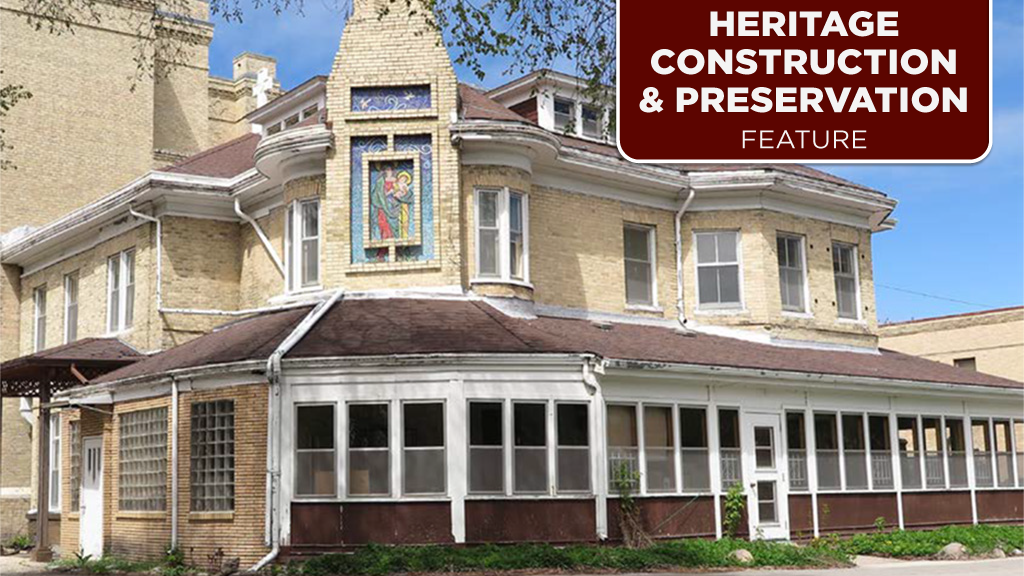To be or not to be, that is the question for Leacock House, Winnipeg’s oldest protected heritage building, and many people want an answer.
The former mansion, completed in 1882, belongs to Marymound, a Winnipeg social services organization, and is located on its grounds in residential West Kildonan.
In 2012, Winnipeg City Council put Leacock House on the municipality’s Buildings Conservation List as a Grade II structure with certain “character defining elements.”
Leacock House thereby joined 355 other historical Winnipeg properties that have full by-law protection from demolition.
The 7,500-square-foot structure is an example of the Queen Anne Revival architectural style, featuring bay windows with curved glass, irregular rooflines, ornamented chimney stacks, a mix of materials and colours, tin ceilings and wood trims, among other features.
The house was built by Edward Philip Leacock, who was the uncle of author and humourist Stephen Leacock, and who became well-known while he lived in Winnipeg for his exuberant, spare-no-expense lifestyle.
Marymound has been raising money to create The Pelletier Hope Centre Transition Home for Mental Health and Complex Needs.
The centre will provide programs and services for teenage girls, who will stay in the house for up to 18 months as they learn life skills and prepare to integrate into community life.
Marymound’s original plan called for housing the Pelletier Centre in Leacock House, after renovating and refurbishing the 140-year-old mansion “to preserve and honour the original design and respect its historical significance.”
But, since then, Marymound’s game plan for the new facility and for Leacock House has changed.
According to a Marymound spokeswoman, the rising costs of construction have made it too expensive to maintain the historical features and heritage status of Leacock House, “especially since we know that donors have gifted us money because they believe the treatment home is important, and not because they are invested in preserving a historic home.
“Additionally, it has always been a challenge to make this space work to provide a suicide-safe environment for the youth supported through the program.
“It is essential that Marymound is creating a space that is safe for those served by the organization. It is also important that Marymound is making best use of donor dollars.”
On top of that, Leacock House has been vacant for several years and is in urgent need of extensive repairs.
As a result, Marymound has applied to de-list the building as a protected heritage resource, so it can be demolished.
“With no compatible use envisioned for the foreseeable future, Marymound does not have the funds to adequately repair and maintain the resource and its deterioration is expected to continue,” the application reads.
“After years of analysis at Marymound’s expense… the not-for-profit organization has come to the unfortunate conclusion that they need make application for de-listing and ultimate demolition…”
Leacock House is not yet dead, however. The City’s Historical Buildings and Resources Committee has recommended that Leacock House retain its historical designation and avoid demolition.
Councillor John Orlikow, chairman of the committee, said its recommendation was based on Leacock House’s heritage values alone, not its economic viability.
The matter now goes to the Standing Policy on Property and Development, Heritage and Downtown Development Committee for its recommendation.
That committee will take into account more aspects of Marymound’s application than just Leacock House’s value as a heritage building.
Murray Peterson, a heritage officer in the City’s Planning, Property and Development Department, says it is unlikely there will be a final decision until after the Winnipeg municipal elections, which take place on 26 October 2022.
Although Leacock House’s future looks shaky, it appears there might be a way for the former mansion to be preserved and for the Pelletier Centre to be built as a stand-alone facility.
Said Marymound, “This project has been an ongoing effort to explore opportunities for better serving the community.
“Marymound, with the support of Heritage Winnipeg [a non-profit charity that promotes the restoration, rehabilitation and preservation of Winnipeg’s built environment] would welcome donors who are solely interested in historic preservation of the house, while also continuing to move ahead with our vision of a healing home for vulnerable youth.”
Marymound’s spokeswoman says the organization is “not necessarily collecting money or seeking donations at this time to preserve the house, but if someone came forward willing to fund that, we’d consider it.”
Marymound is holding two community engagement events about the Pelletier Centre and Leacock House on Wednesday, August 31, 2022, from 3:00 PM to 5:00 PM and from 6:00 PM to 8:00 PM.
For more information, contact info@marymound.com











Red River Polytechnique has a restoration program whereby students learn about heritage restoration in our city. It seems to me that Leacock House, the oldest home in Winnipeg, is the perfect restoration project for learning about architecture of the late 1800’s. We travel to Europe to see such architecture, and here, we tear it down. Which begs the question? Why do we not have a National Restoration Department funded by both provincial and federal governments? This does not solve Marymound’s dilemma, but it certainly makes me wonder about restoring and preserving such heritage buildings and homes.
Possibly Marymount can be restored, slowly, while another facility is built. The grounds are certainly large enough to restore this iconic Queen Anne style of architecture whilst building another facility.